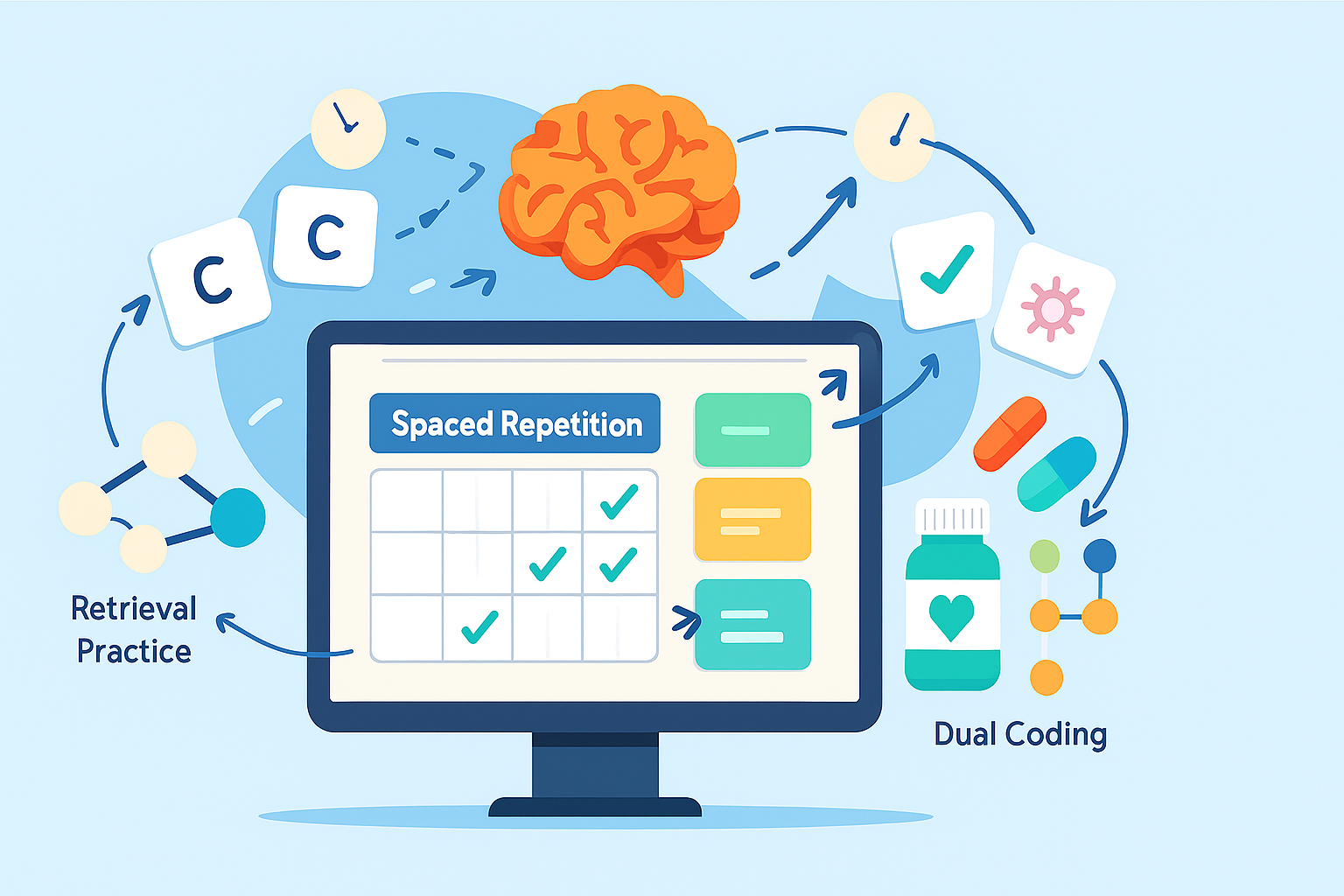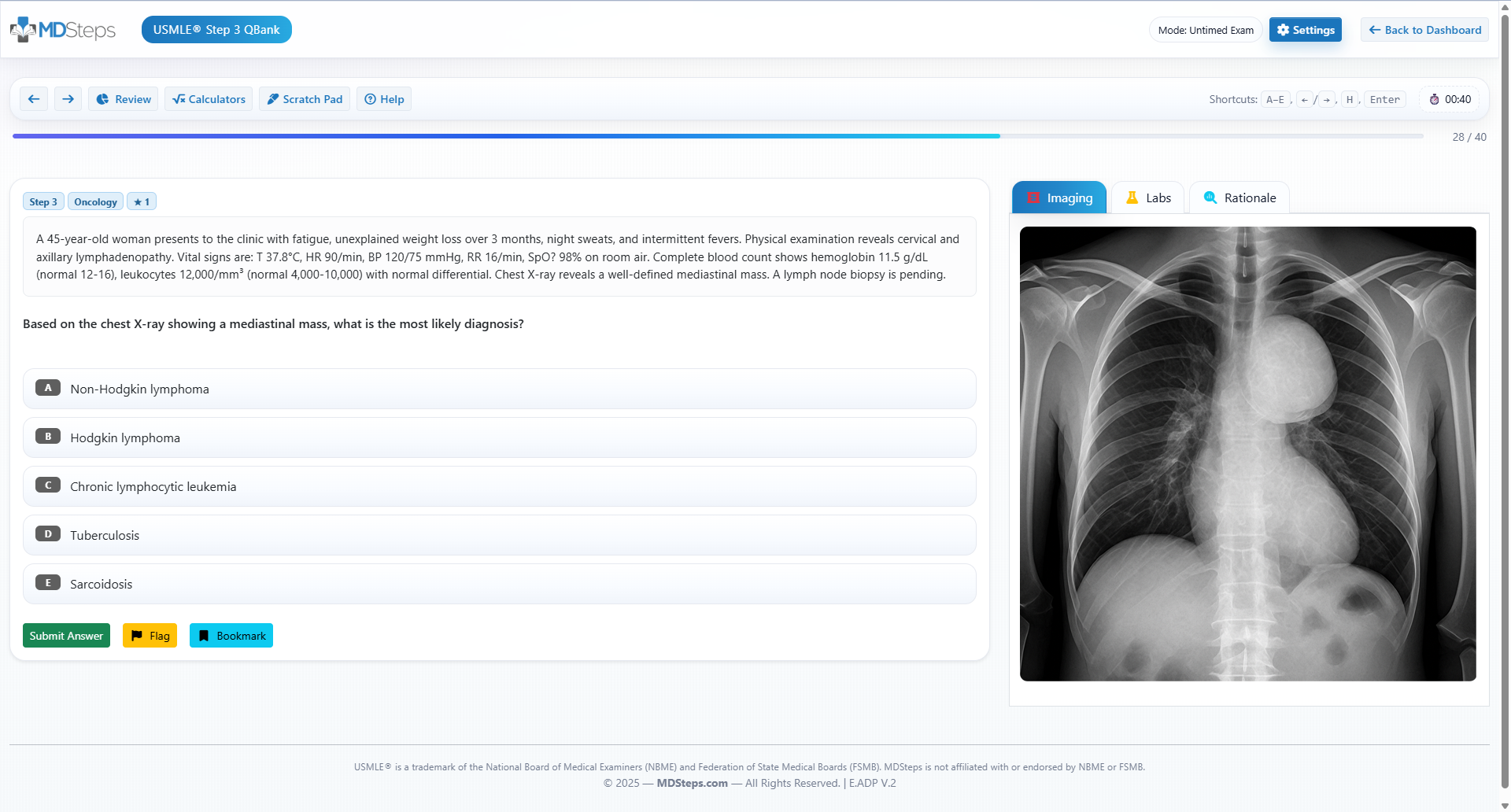Step 1 rewards stable recognition plus flexible recall: you must retrieve mechanisms, differentials, and exception rules under time pressure. The most reliable way to build this is not rereading or highlighting, but a blend of retrieval practice (actively pulling information from memory), spaced repetition (revisiting just before you would forget), and dual coding (combining words and visuals). Decades of learning research show that testing yourself outperforms restudying; spacing out practice consolidates memory traces; and attaching images or scenes to concepts adds additional retrieval cues that survive stress. On exam day, these cues surface quickly when stems include familiar triggers—enzyme names, bug habitats, or side-effect clusters. Practice exactly how you’ll be tested—adaptive QBank, live CCS, and clarity from your data. Think of your brain’s Step 1 storage as three buckets. Bucket A: Core anchors (e.g., rate-limiting enzymes, Gram-positive patterns, autonomic pharm). These should be overlearned with short retrieval cycles until they feel automatic. Bucket B: Linking rules (e.g., “enzyme deficiency → metabolite accumulation → clinical triad”; “MOA → class adverse effect”). These form the mental bridges you use to reason through unknown stems. Bucket C: Low-yield decor (e.g., eponyms, rare exceptions). These can be lightly tagged or pruned to prevent cognitive overload. Your daily routine must preferentially feed Buckets A and B while keeping Bucket C from siphoning attention. Operationally, that means two things. First, every serious study block should end with self-testing—Q-bank items, short-answer prompts, or flashcards—so you measure what comes out of memory, not what goes in. Second, the timing of reviews should be algorithmic, not emotional. Spaced repetition software (SRS) like Anki predicts when you are likely to forget and schedules a minimal dose just before that point. This is how you convert 1–2 passes into 6–10 effective encounters with near-zero wasted time. Finally, visual-mnemonic linking (e.g., “Sketchy-style” scenes or your own diagrams) gives you a handle to grab when the stem is long and noisy—especially for micro and pharm where mechanism clusters, morphology, and toxicities can be encoded as memorable images. Your daily loop should be predictable, short on decision-making, and ruthless about completion. The goal is to eliminate variability so your cognitive energy goes to recall. Here’s a robust Step 1 template: (1) warm-up with 10–15 rapid cards (core anchors), (2) 40–80 new/young cards (targeted to current system), (3) finish all due reviews, and (4) a 40-question Q-bank block feeding new cards into tomorrow’s deck. Keep the total to ~90–120 minutes of SRS across the day (split AM/PM). When review piles balloon, throttle new-card intake—not review completion. Key settings: For Step 1, set Learning steps to two to three quick intervals—e.g., Workflow: Tag by organ system and concept class (e.g., Step 1 cards must compress complex mechanisms into bite-sized, testable prompts. Follow the Minimum Information Principle: each card should ask for one idea that you can answer in under 10 seconds. Prefer cloze deletions over Q/A blocks because cloze forces retrieval in context and enables variants without duplication. Example: “In phenylketonuria, the deficient enzyme is {{c1::phenylalanine hydroxylase}}, leading to accumulation of {{c2::phenylalanine}} and decreased {{c3::tyrosine}}.” Now you can test enzyme, accumulation, and downstream product independently. Use mechanism-first framing: instead of “What is the side effect of isoniazid?”, ask “Isoniazid inhibits {{c1::mycolic acid synthesis}} and can cause {{c2::peripheral neuropathy}} via {{c3::B6 deficiency}}.” This mirrors how exam stems present data (MOA → adverse effect → biochemical rationale). Incorporate diagnostic pivots—clues that distinguish similar entities (e.g., “liver fluke → cholangiocarcinoma risk” or “Auer rods → MPO+”). When possible, embed if–then rules (e.g., “If ↑β-oxidation defect (MCAD) then {{c1::hypoketotic hypoglycemia}} during fasting”). Do: keep sentences short, bold the cloze context keywords, and add 1–2 cross-links (“See also: urea cycle defects”). Don’t: make trivia cards (“eponym-only”), stack multiple unknowns in one prompt, or duplicate the same fact across decks (creates leeches). For images, attach one high-yield figure (e.g., pathway snippet or pathogen image) and ask a single retrieval (“Which step is inhibited?”). Finally, tag cards by error source ( Classic spacing studies show that review just before forgetting maximizes efficiency. In practice, you don’t need to calculate decay curves—let SRS do that—yet having guardrails helps tune expectations and spot problems early. New facts deserve an early “overlap” (same day and next day) followed by widening gaps. Mature facts can stretch out, but anything tied to mechanisms you routinely apply (e.g., pharmacodynamics, rate-limiting enzymes) should revisit more frequently than raw lists (e.g., obscure eponyms). Use the matrix below as a pragmatic target for average interval ranges in full-time Step 1 prep. If your “Again” rate on mature cards exceeds ~10%, you’re spacing too aggressively or your cards are too dense. Integrate interleaving: mix related but confusable topics (e.g., glycogen storage diseases) within one session so you practice discrimination, not just recognition. Pair this with brief generation (try to outline a pathway from memory before revealing), then use cards to check accuracy. When energy is low, accept slightly tighter intervals for anchors rather than skipping a session—consistency beats ideal spacing. Visual scenes create multiple retrieval cues: location, characters, interactions, and props. For Step 1, you don’t need artistic talent; you need consistent iconography and relational mapping. Build a simple palette (e.g., “mushrooms” for fungi, “purple staph staff” for Gram-positive cocci, “electric eels” for sodium channels). When encoding a drug class or enzyme pathway, assign a location that matches the organ system (e.g., a “renal workshop” with pipes and filters). Each mechanism becomes an interaction (e.g., “beta-blocker knights shielding β-banners”), and each adverse effect becomes a consequence (e.g., “fatigued knights dropping shields → bradycardia”). Encode why the effect occurs, not just the list. Workflow to build a scene in 8 minutes: (1) Write 3–5 core facts you must retrieve (MOA, indication, hallmark AE). (2) Choose icons from your palette. (3) Sketch a thumbnail or mental map; label minimally. (4) Speak a 15–20 second audio summary while viewing the scene to link verbal and visual codes. (5) Create 3–6 cloze cards anchored to the scene (“In the ‘renal workshop’, {{c1::ACE inhibitors}} reduce {{c2::GFR}} initially via {{c3::efferent arteriolar dilation}}.”). (6) On review, reconstruct the scene briefly before answering. This preserves the spatial scaffold that long stems will reactivate. For micro, scenes shine when distinguishing look-alikes. Example: “curved comma by the sea” (Vibrio cholerae) vs. “Gull wings in camp” (Campylobacter). For biochem, animate a single carbon unit moving through enzymes; for pharm, narrate MOA → therapeutic effect → toxicity as a chain of cause–effect events. Keep scenes small (postcard-sized), stable (reuse icons), and evolving (add detail only when needed). If a scene stops pulling its weight—too busy, too cute—simplify or replace it. Your visual system is a powerful ally, but only if the cues remain crisp under stress. Your Q-bank is not only for assessment; it’s your most potent content generator. After each 40-question block, create 3–8 cards total (not per question). Each card should capture a hinge that would have flipped your answer: a mechanism, a pivot symptom, or a rule-of-thumb threshold. Avoid transcribing entire explanations—this bloats decks and drowns signal in noise. Use a template like: “Because {{c1::fluoroquinolones}} inhibit {{c2::DNA gyrase}}, they prolong {{c3::QT interval}} and risk {{c4::torsades}}—especially with {{c5::hypokalemia}}.” Now you have five testable links that recur across stems. Tagging strategy: Apply Block review cadence: (1) Tally misses and “guessed right” quickly. (2) Identify 1–2 patterns (e.g., “overlooking pathognomonic histology,” “confusing MOA within a class”). (3) Create cards only for patterns. (4) Add one rule card per pattern (“If cholestatic pattern (↑ALP, ↑direct bili) + pruritus in a woman with autoimmune hx → think {{c1::PBC}}; confirm with {{c2::anti-mitochondrial antibodies}}.”). (5) Link these tags to a weekly 80-question cumulative block to check for transfer. Over 2–3 weeks, your deck should reflect your unique blind spots, not a generic syllabus. What kills SRS isn’t difficulty—it’s debt. When reviews pile up, anxiety rises, quality drops, and the system collapses. Prevent this with three levers: prune, pace, and protect. Prune anything that doesn’t advance mechanism-based reasoning or high-frequency recognition. Pace by capping new cards when review counts exceed preset thresholds (e.g., 200+ due = new cap 20). Protect your best hours for retrieval (usually mornings) and defend them from admin tasks and messaging. Pruning rules: Delete pure trivia unless it connects to a mechanism or classic stem cue. Replace long lists with category rules (“All aminoglycosides → nephro/ototoxic via {{c1::30S inhibition + ROS}}.”). Merge duplicates; if two cards test the same fact, keep the clearer one. For leeches (cards that repeatedly fail), diagnose the cause: Is the prompt vague? Is interference high (two look-alikes)? Is the fact simply not worth it? Rewrite, add a discriminating cue, or drop it. Throughput planning: Aim for a stable daily cadence you can finish 90%+ of days. For full-time prep: 60–80 new cards/day with 150–220 reviews is sustainable for most learners after a 1–2 week ramp. For part-time: 30–40 new, 100–160 reviews. Use a weekly “reset” hour to clean tags, delete junk, and re-balance filtered decks. If burnout signals appear (rising Again rate, slipping accuracy, dread), cut new intake by 50% for three days and run short, high-focus review sprints (15 minutes, timer on) to restore momentum. Four weeks out, your objective shifts from acquisition to stabilization and transfer. Week −4 to −3: Reduce new cards by ~25–40%; increase cumulative Q-bank blocks (2/day if full-time). After each block, create only pattern-based cards. Run filtered decks that interleave your top three weak systems. Week −2: Freeze new cards entirely for 5–7 days. Focus on due reviews, high-yield pivots, and 60–80 question mixed blocks. Start exam-day simulations with pacing (75 questions with strict timing, one break mid-way). Week −1: Taper volume by 20–30%, emphasize accuracy and confidence. Curate a one-page “Anchors” sheet: top MOA→AE links, rate-limiting enzymes, hallmark bugs. Daily crunch routine: AM: all due reviews (no carryover). Midday: one mixed block (40–44 Qs), rapid error analysis → 3–5 cards. PM: short targeted review (15–20 minutes) of hardest tags (e.g., Even good systems wobble. If your recall feels sticky but slow, prioritize speed drills: set a 10-second cap per card and accept imperfect recall to build fluency. If accuracy drops during long stems but is fine on cards, increase transfer practice with case vignettes and require yourself to state the mechanism link before reading the explanation. If scenes feel childish or forgettable, your iconography is inconsistent—create a one-page legend and rebuild the 10% most-used scenes with stable symbols. If you feel overwhelmed by reviews, your bottleneck is likely card quality: split multi-concept cards and add discriminating cues (e.g., “organophosphates → AChE inhibition → DUMBBELSS” vs. “atropine → competitive muscarinic antagonist → antidote”). Metrics that matter: (1) Mature-card Again rate (target < 10–12%). (2) Daily review completion (≥ 90% of days). (3) Q-bank transfer: rising correctness on previously weak tags. (4) Session duration stability (±15 minutes). Ignore vanity metrics like total card count—only effective cards move scores. Once weekly, perform a 20-minute “quality audit”: sample 30 cards from your hardest tag, delete 10%, rewrite 20%, keep 70%. This keeps the deck lean and potent. Here’s your Step 1 memory OS in nine lines: (1) Daily: complete all reviews. (2) New intake capped by review load. (3) Cards = one idea, cloze-first, mechanism-first. (4) Tags by system, concept, and source; weekly filtered interleaving. (5) Q-bank → 3–8 pattern cards; no transcription. (6) Scene-based linking for micro/pharm/biochem; keep icon legend. (7) Weekly audit to delete/repair low-utility cards. (8) Crunch protocol four weeks out; freeze new two weeks out. (9) Protect mornings for retrieval; move admin to evenings. If you implement this as written for four weeks, you’ll experience smoother recall, faster stem parsing, and a measurable lift in mixed-block accuracy—because your study now mirrors how memory actually works. Remember: sustainable gains come from consistency, not heroic weekends. When life intrudes, shrink the session, not the frequency. A 20-minute review finished today beats a perfect 90-minute session that never happens. The Step 1 curve doesn’t reward who reads the most; it rewards who retrieves the right links under time. Engineer those links, space them wisely, and anchor them to scenes your brain can find when it matters.Why Memory Engineering Beats Cramming for Step 1
Master your USMLE prep with MDSteps.
100+ new students last month.
Build Your Daily Anki Loop (Settings That Actually Matter)
15m 6h 2d—so new facts get a same-day and next-day check. Graduating interval around 4–7 days keeps early spacing tight. Easy bonus ~1.3–1.5 limits runaway intervals for “too easy” ratings. Maximum interval can remain high; the algorithm will self-regulate. Use bury siblings to avoid seeing near-identical variants on the same day (curbs interference). Consider a daily new card cap of 60–80 when in full-time study; part-time learners may choose 30–40. Above all, never leave reviews incomplete—this compounds forgetting and stresses future sessions.#heme #enzyme-defect; #micro #anaerobes; #pharm #adrenergic). Create filtered decks nightly for tomorrow’s focus (e.g., “Renal review due + tag:#acid-base”). After your Q-bank block, convert one insight per missed or guessed item into a card—preferably a cloze deletion that captures the precise diagnostic or mechanistic hinge you failed to retrieve. Use keyboard-only navigation to maintain pace, and insert 2–3 micro-breaks (60–120 seconds) to reduce fatigue-based errors.Daily Time Budget
Throttle Rules
Design Cards That Survive Long Stems (Cloze-First, Mechanism-First)
#missed-qbank, #hesitated, #guessed-right) so your filtered reviews address actual test weaknesses, not imagined ones.Card Hygiene Checklist
Spacing That Works: Practical Intervals for Step 1 Content
Content Type Early Learning Steps Graduation Target Typical Mature Intervals Notes Enzyme defects & pathways (Biochem) 15m → 6h → 2d 4–7d 10–25d → 30–60d Favor cloze sets (defect→metabolite→clinical triad). Micro organism IDs & key features 10m → 4h → 1d 3–5d 7–20d → 25–45d Add image/scene cue; interleave by Gram and shape. Pharmacology MOA → AE patterns 15m → 8h → 2d 5–8d 12–28d → 35–70d Mechanism-first; group by system (CV, Neuro, ID). Immunology & high-yield anatomy 10m → 6h → 1d 3–6d 10–25d → 30–50d Use diagrams for pathways and lymph drainage. Low-yield trivia / eponyms — — Prune aggressively Delete if not connected to mechanisms or patterns. Sketchy-Style Linking: Turn Mechanisms into Scenes You Can Re-Enter
Scene-Building Pitfalls
From Q-Bank to Card: A Tight Pipeline for Durable Gains
#system (e.g., #GI, #renal), #concept (#MOA, #adverse-effect, #lab-interpretation), and #source (#uworld-2025-Block12). Weekly, run a filtered deck of due cards + the last 7 days of #missed-qbank—this is your “error echo.” If a card remains leechy after 3–5 laps, fix the question, not your willpower: split it, rewrite with more context, or add a visual cue. If you guessed right but felt shaky, mark the card #hesitated; these are the ones that crumble under fatigue.Load Management: Pruning, Leeches, and Sustainable Throughput
Debt Protection Triggers
The Exam-Crunch Protocol (Final 4 Weeks to Test Day)
#heme-onc, #renal-phys). Insert brief visual refreshes for scene-based sets (60–90 seconds each). Two days out, stop creating new cards. The day before, perform a light jog through anchors and a single, easy review session to reduce arousal, then rest.Rapid-Review Checklist (Carry into Test Week)
Troubleshooting Guide: When the System Misfires
If… Then…
Red Flags
Putting It All Together: A One-Page Operating System
Selected References & Further Reading
Memory That Sticks: Spaced Repetition & Sketchy-Style Linking for Step 1.







